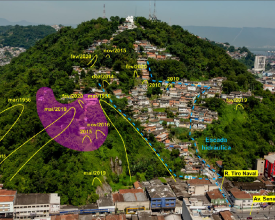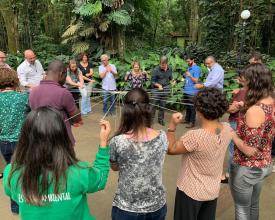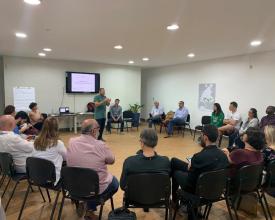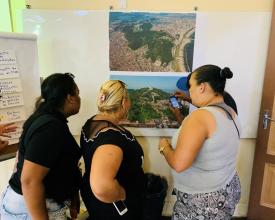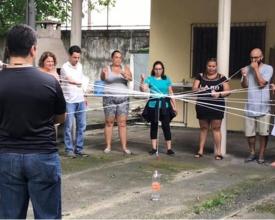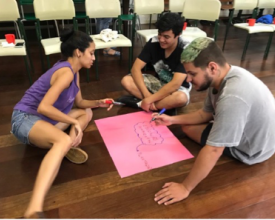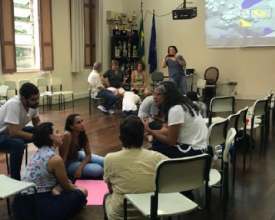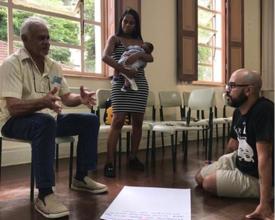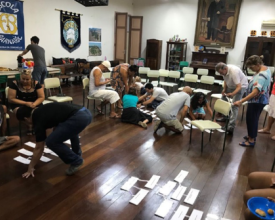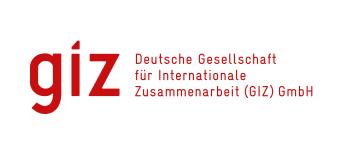
Community and gender oriented Ecosystem-based adaptation measure: The Monte Serrat case, Brazil
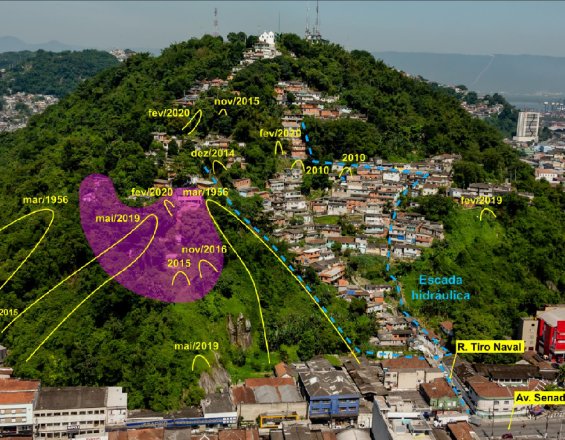
Due to population density and high cost of living, many families occupied hill areas classified as high risk due to deforestation and increase of rainfall which leads to soil erosion and frequent landslides, causing destruction of homes and even deaths.
This scenario led to the removal of families to affordable housing. Unoccupied areas need a new use to avoid illegal occupation. The city hall and the community, with the support of ProAdapta, started a process of participatory discussion on the design of an Ecosystem-based Adaptation (EbA) measure for the site, using restoration of native forests with a focus on climate change adaptation and, at the same time, on the well-being and resilience of local communities. Through the use of inclusive and non-sexist language and group dynamics with city hall staff and members of the community about recognition of privileges and differences in the perception of climate risk between men and women, it was possible to raise awareness about gender equity.
Context
Challenges addressed
The main challenges were:
- Environmental: access to the hill, especially during rainy seasons. Also, deforestation of hills and, consequently, erosion and landslides, due to the effects of climate change and loss of biodiversity.
- Social: integration between sectors of the City Hall; difficulty in engaging community residents and in gaining the community's trust; Social vulnerability and marginalization of residents; Cultural entrenchment in place making the relocation process more time consuming;
- Economic: allocation limitation of funds for the implementation of the EbA methodology; Limitation of resources and options for better housing for residents.
Location
Process
Summary of the process
The participatory approach (building block 1), allowed the integration of local community actors, city hall technicians, NGOs involved in Monte Serrat and consultants of GIZ-ProAdapta. This way it was possible to develop awareness-raising initiatives regarding gender equity, present in building block 2.
The integration of actors also enabled learning experiences and exchange between technicians from the municipality. This way, it was possible to establish an integrated view on planning for adaptation to climate change in the city, leading to building block 4. The project integrated views from different sectors of the City Hall and led to the connection between public policies, having the EbA approach as a cross-theme to them.
Due to the significant level of engagement of multi sectors in the Monte Serrat EbA measures achieved in the participatory process, described in building blocks 1 and 2, it was possible to make progress, despite COVID19, in terms of public policies development that include EbA and approval through remote meetings using google earth and participatory methodology tools (building block 3).
Building Blocks
Participatory approach – Community-based solutions
The sense of community on Monte Serrat and surrounding hills was fundamental to choose an active social participation approach. After all, it is the people living there who feel the impacts caused by climate change, such as landslides. The frequent visits by the Municipality Hall (Civil Defense) and the constant contacts with locals were extremely important to gain the trust of the community, especially to engage young people and more recent residents in the area.
The relocated families were invited to participate in the workshops to value their history and the ties built in the region and to take advantage of the benefits of the EbA measure.
The strategy of the participatory approach, joint between public authorities, civil society and the assistance of ProAdapta, (i) built community knowledge about climate change and its link to local climate vulnerability and (ii) strengthened relationships of trust among the diversity of stakeholders involved. The high-risk areas that have been vacated need to be urgently and consensually designated before any attempt of reoccupation, therefore the urgency of the EbA workshops.
Residents of other neighboring hillsides that suffer from the same landslide problems were invited to participate to replicate the methodology and upscale the solution.
Enabling factors
- Commitment and cooperation by the city’s technicians from several departments in favor of the EbA solution
- Posters about workshops on Monte Serrat with the slogan ‘Let’s take care of our hill’, awakening the feeling of belonging and well-being
- Special invitation using inclusive, non-sexist language to ensure that women feel addressed
- The strengthening of the residents’ representative organization through dialogue fostered by the Municipality, supported by ProAdapta
- Restoration of the Municipal Commission on Monte Serrat’s Urbanization and Legalization
Lesson learned
- Initiate local dialogue with the community through ‘champions’ to engage potential and internal allies before opening and communicating the idea to external people.
- Observe the potential alternatives of EbA measures in the mountain Monte Serrat while communicating with the local community.
- It helps if the city is working simultaneously on public policy instruments on adaptation to climate change. In Santos’ case: (a) update of the municipal plan on climate change and (b) building of the Municipal Plan on Recovery and Conservation of the Atlantic Rainforest with climate and EbA lenses with different actors’ engagement.
- Document a consolidated methodology in flyers and videos to upscale EbA to other hills.
- Climate risk communication must be done consciously and adopting an accessible language. It must also reflect related legislation and the need of intervention, always respecting the community rights to information access, the participation in decision-making of actions that directly affect the community and the right to adequate housing.
Gendered Community-based EbA solution
The gender approach of Monte Serrat recognizes women as victims but also part of the solution. Climate change affects groups that are socially, environmentally, and economically vulnerable differently, be it women, indigenous peoples or communities. On the other hand, women's decision-making responses to climate risks can be faster and more efficient.
It is essential to think of solutions that respect the right to non-discrimination of these groups. Guided by international recommendations, gender mainstreaming favors the participation and equitable engagement of all people living in Monte Serrat. In addition, the idea was to promote representativeness in the technical staff responsible for implementing the EbA measures.
Gender equity was reinforced in all stages and resulted in greater participation of women, including pregnant, nursing and women with newborns and babies, without the embarrassment of bringing children to the workshop space. They were welcomed and given special attention through the support of the municipality's Secretariat of Social Assistance.
This made it possible for women to feel comfortable to contribute to the construction of EbA solutions that benefit them directly, by giving suggestions for a recreation area for their children with fruit trees that could be used in cooking.
Enabling factors
The dynamic Avante/Personare, helped to raise awareness on gender and climate vulnerability to the municipal staff. Based on empathy, the activities relied on fictional characters and cases to work on the recognition, especially in a climate emergency, of privileges in terms of class, race and gender with the community and the technical team. The experiences caused reflections and discomfort about unequal relations that were not previously present among the trained people.
Lesson learned
Suggestions to include more women in the next steps of the participatory process include holding workshops for socio-environmental education, focusing on the impact of climate change on vulnerable groups. Implementation must rely on transparent actions of the involved local agencies to always include women and communicate with them in the same way as with men.
It is important to care about the language used for inviting women to the workshops. It should build a welcoming and trusting environment to make women feel comfortable talking about their perceptions, ideas and needs. Many women stopped participating in the workshops, especially on weekends, when they did not have someone to leave their kids with. Once the problem was identified, a creative solution to accommodate the children was successfully put in place. The commitment of the parties was fundamental to constantly reinforce the application of the gender lens in the environmental solutions. The effectiveness of implementation depends on the joint approach between gender, socio-economic vulnerability, climate change, and environmental restoration.
Implementation Approach: Virtual Actions after planning and engagement– Due to Covid
In the period at the end of 2019 and beginning of 2020, together with the Community Association, dialogues began to plan the implementation of the EbA proposal. The suggestions of residents, city hall technicians and the GIZ team were observed. However, in February and March 2020 there were torrential rains (extreme events) that caused landslides on Monte Serrat and other hills in the municipality, causing death in some of them and destruction of homes, making it impossible to continue the work.
While the community was recovering and restructuring, the COVID pandemic began and, with that, the cancellation of all the activities of the actors involved. During this period, the community also remained united, seeking to minimize the damage caused by job losses and illnesses caused by the pandemic.
In the brief period between the end of the rains and the beginning of the pandemic, the city's technicians started to recover the slopes of some hills by planting native species according to the EbA methodology learned. However, the pandemic prevented the continuation of all work on Monte Serrat and on the other hills.
After adapting to the new pandemic scenario, during 2020 and 2021 virtual meetings were held in order to monitor the situation of the community, to resume activities and plan the Communication project.
Enabling factors
- Strengthening the representative organization of residents through dialogue promoted by the City Hall and supported by ProAdapta;
- Before the COVID pandemic, face-to-face training carried out with city hall technicians by the ProAdapta team;
- The importance of virtual and face-to-face interaction with community leaders (Association of Residents) to maintain contact with the community.
Lesson learned
- The strengthening of the Residents' Association is fundamental for the agility and efficiency of the community in responding to extreme events and the pandemic;
- Maintaining contact with the community through the Residents' Association made it possible to know and understand what the community was going through and how to interact with it;
- The respect and mutual trust acquired during the construction of the EbA proposal, before the extreme events and the COVID pandemic, made it possible to resume and adapt the project in the form of communication actions for the community and for the other hills of the municipality;
- The training of technicians from the city hall made it possible to incorporate EbA principles into actions on other hills after extreme events;
- The reframing of collective spaces within the community, with emphasis on the use to implement EbA measures;
- The lack of nurseries for seedlings of native species and a pre-established model for the restoration of native forest areas and environmental services makes it difficult to acquire adequate species for the implementation of the EbA proposal.
CONNECTION WITH PUBLIC POLICIES: Santos Climate Action Plan (PACS), Conservation and Restore of Atlantic Forest Plan (PMMA) and Sao Paulo State Climate Action and Race to Resilience
The EbA measure was discussed and included as a practical implementation measure during the development of the following public policies in the region: (a) PACS - Santos Climate Action Plan
(b) Municipal Plan for Recovery and Conservation of the Atlantic Forest (PMMA) (c) Subnational adaptation governance study and (d) São Paulo State Adaptation Plan under the Race to Resilience
The construction of these plans and guides was made with the involvement of a large number of diverse actors, were approved and will be launched on January 2022.
While the inception phase of the EbA measure at Monte Serrat, in 2019 the elaboration of the PMMA and PACS began to be discussed and were finally approved in 2021. Since the beginning, the PMMA applied the EbA cycle and gender equity and climate change lens.
The EbA methodology was characterized as a common goal of the multi sectors that encouraged diverse political will and allowed the integration between environmental, urban and risk reduction policies in the municipality of Santos. Public policies institutionalizing enables EbA enhancement, replication and involvement of the private sector.
Enabling factors
- The coordination of actions, policy discussions by the CMMC made it possible to unite the measure, events and public policies under construction
- The torrential rains of 2020 contributed to a careful and in-depth look at the municipality´s Climate Risk Analysis and PMMA´s EbA chapter, enabled the integration of EbA knowledge into other sections and projects including the private sector
- Solid governance allowed the allocation of relevant staff from multi sectors, involvement and engagement of other secretariats and municipal councils towards the EbA common goal
Lesson learned
- EbA measures helped to enhance the political will of municipality officers and population to develop and approve its related public policies as PMMA and PACS.
- The existence of a municipality database was significantly important;
- The need to carry out research/studies in the municipality area by local educational/research institutions to create/feed the database;
- The participation of different municipal secretariats is essential for the development of the public policies PMMA and PACS proposal;
- The operation of municipal councils with the participation of institutions and representations from different sectors (private, non profit and public) provided important technical and political support in the development of projects and policies;
- Support and interaction with other municipal councils strengthened discussions and critical analysis.
- Institutional partnerships and GIZ´s support with capacity building consultancy teams on EbA methodologies and strategy designs played a great role for the results achieved.
Impacts
The case of EbA in Monte Serrat, Santos has the following positive impacts:
- It enabled the joint work between various sectors of the city hall (Secretary of Works, Urban Development, Environment, Public Safety, Social Assistance, Health, Administration of the Hills) as well as civil society institutions (Association of Improvements of Monte Serrat, NGO Warriors of Peace), promoting dialogue for a common good and building trust between City Hall secretariats, departments and civil society;
- It promoted training for technicians and the community on the EbA methodology, which integrates the relationship between human, ecosystem services and climate resilience;
- It allowed for reflection on gender equity and the unequal impacts of climate change;
- It promoted income for the community, as the workshops were developed with the support and labor of women from Monte Serrat;
- It promoted reflections on the importance of biodiversity and ecosystem services;
- It opened a horizon of possibilities and opportunities for the community and gave a new meaning to the natural environment as a possible source of income and food security.
Beneficiaries
On Monte Serrat live 654 men and 721 women who benefit from the project´s work. 40 technical servants from the City Hall of Santos were trained. The replication of the methodology for scaling up is being worked on at the regional level with 8 more cities.
Sustainable Development Goals
Story
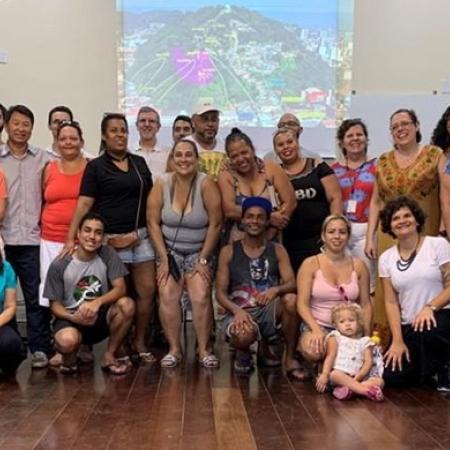
"I, Arquimedes, have a personal commitment to fight to take Monte Serrat to the best places and bring the best to the hill I live, but we still face (many residents) discouragement due to long years of neglect and delay. It is still difficult to get out of that (urban) culture being born here, but I allowed myself to learn about new experiences and open the doors of Monte Serrat for everyone and get to know the Ecosystem-based Adaptation - EbA methodology.
And today we can see the possibilities coming, being part of a unique project aimed at transforming the environment we live in. Reducing the impact we ourselves have on Monte Serrat is like asking forgiveness from this mountain.
Our mission is great, our responsibility is enormous and I see how important it is for our residents to see how the technicians of this project see it. My imagination draws and reproduces a perfect world, because I can't allow myself to see something other than that, because that's what we live in today.
The resident's self-esteem needs to be conquered and I will do what I can so that there is the participation of the residents. The feeling of belonging exists, but it is shaken by the possibility of leaving here and others who are still disbelieving by vote buying policy”.
Arquimedes Machado, president of the Monte Serrat Improvement Association, 13 March 2020
